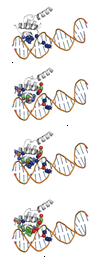DNA-binding residues and binding mode prediction with binding-mechanism concerned models
- PMID: 19958487
- PMCID: PMC2788376
- DOI: 10.1186/1471-2164-10-S3-S23
DNA-binding residues and binding mode prediction with binding-mechanism concerned models
Abstract
Background: Protein-DNA interactions are essential for fundamental biological activities including DNA transcription, replication, packaging, repair and rearrangement. Proteins interacting with DNA can be classified into two categories of binding mechanisms - sequence-specific and non-specific binding. Protein-DNA specific binding provides a mechanism to recognize correct nucleotide base pairs for sequence-specific identification. Protein-DNA non-specific binding shows sequence independent interaction for accelerated targeting by interacting with DNA backbone. Both sequence-specific and non-specific binding residues contribute to their roles for interaction.
Results: The proposed framework has two stage predictors: DNA-binding residues prediction and binding mode prediction. In the first stage - DNA-binding residues prediction, the predictor for DNA specific binding residues achieves 96.45% accuracy with 50.14% sensitivity, 99.31% specificity, 81.70% precision, and 62.15% F-measure. The predictor for DNA non-specific binding residues achieves 89.14% accuracy with 53.06% sensitivity, 95.25% specificity, 65.47% precision, and 58.62% F-measure. While combining prediction results of sequence-specific and non-specific binding residues with OR operation, the predictor achieves 89.26% accuracy with 56.86% sensitivity, 95.63% specificity, 71.92% precision, and 63.51% F-measure. In the second stage, protein-DNA binding mode prediction achieves 75.83% accuracy while using support vector machine with multi-class prediction.
Conclusion: This article presents the design of a sequence based predictor aiming to identify sequence-specific and non-specific binding residues in a transcription factor with DNA binding-mechanism concerned. The protein-DNA binding mode prediction was introduced to help improve DNA-binding residues prediction. In addition, the results of this study will help with the design of binding-mechanism concerned predictors for other families of proteins interacting with DNA.
Figures



Similar articles
-
Residue-level prediction of DNA-binding sites and its application on DNA-binding protein predictions.FEBS Lett. 2007 Mar 6;581(5):1058-66. doi: 10.1016/j.febslet.2007.01.086. Epub 2007 Feb 7. FEBS Lett. 2007. PMID: 17316627 Free PMC article.
-
ProteDNA: a sequence-based predictor of sequence-specific DNA-binding residues in transcription factors.Nucleic Acids Res. 2009 Jul;37(Web Server issue):W396-401. doi: 10.1093/nar/gkp449. Epub 2009 May 29. Nucleic Acids Res. 2009. PMID: 19483101 Free PMC article.
-
Sequence-based prediction of DNA-binding residues in proteins with conservation and correlation information.IEEE/ACM Trans Comput Biol Bioinform. 2012 Nov-Dec;9(6):1766-75. doi: 10.1109/TCBB.2012.106. IEEE/ACM Trans Comput Biol Bioinform. 2012. PMID: 22868682
-
Three-dimensional structural views of damaged-DNA recognition: T4 endonuclease V, E. coli Vsr protein, and human nucleotide excision repair factor XPA.Mutat Res. 2000 Aug 30;460(3-4):257-75. doi: 10.1016/s0921-8777(00)00031-8. Mutat Res. 2000. PMID: 10946233 Review.
-
An overview of the prediction of protein DNA-binding sites.Int J Mol Sci. 2015 Mar 6;16(3):5194-215. doi: 10.3390/ijms16035194. Int J Mol Sci. 2015. PMID: 25756377 Free PMC article. Review.
Cited by
-
Integrating sequence and gene expression information predicts genome-wide DNA-binding proteins and suggests a cooperative mechanism.Nucleic Acids Res. 2018 Jan 9;46(1):54-70. doi: 10.1093/nar/gkx1166. Nucleic Acids Res. 2018. PMID: 29186632 Free PMC article.
-
An Ensemble Docking Approach for Analyzing and Designing Aptamer Heterodimers Targeting VEGF165.Int J Mol Sci. 2024 Apr 5;25(7):4066. doi: 10.3390/ijms25074066. Int J Mol Sci. 2024. PMID: 38612876 Free PMC article.
-
A Large-Scale Assessment of Nucleic Acids Binding Site Prediction Programs.PLoS Comput Biol. 2015 Dec 17;11(12):e1004639. doi: 10.1371/journal.pcbi.1004639. eCollection 2015 Dec. PLoS Comput Biol. 2015. PMID: 26681179 Free PMC article.
-
Extending Asia Pacific bioinformatics into new realms in the "-omics" era.BMC Genomics. 2009 Dec 3;10 Suppl 3(Suppl 3):S1. doi: 10.1186/1471-2164-10-S3-S1. BMC Genomics. 2009. PMID: 19958472 Free PMC article.
References
-
- Berman HM, Olson WK, Beveridge DL, Westbrook J, Gelbin A, Demeny T, Hsieh SH, Srinivasan AR, Schneider B. The nucleic acid database. A comprehensive relational database of three-dimensional structures of nucleic acids. Biophys J. 1992;63(3):751–759. doi: 10.1016/S0006-3495(92)81649-1. - DOI - PMC - PubMed
Publication types
MeSH terms
Substances
LinkOut - more resources
Full Text Sources

